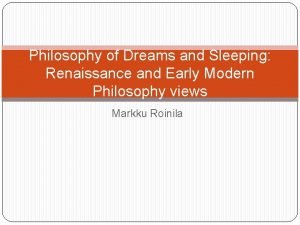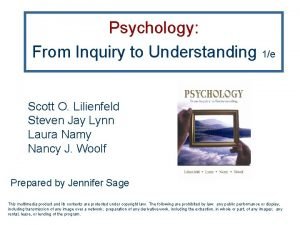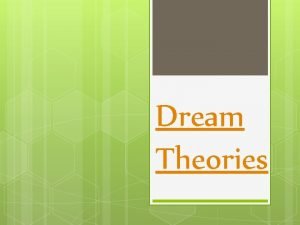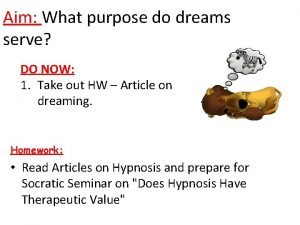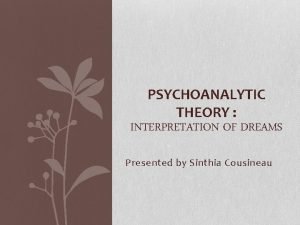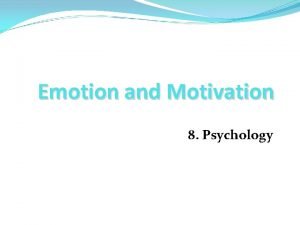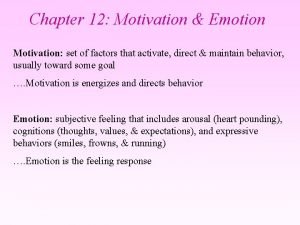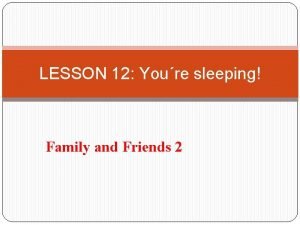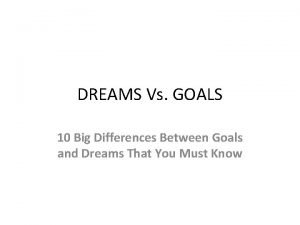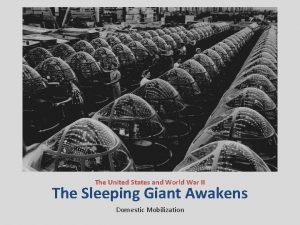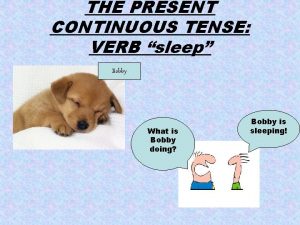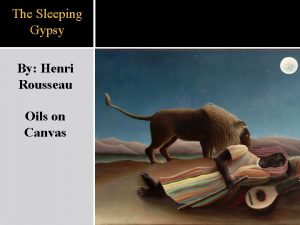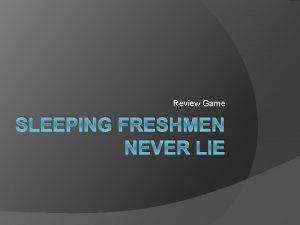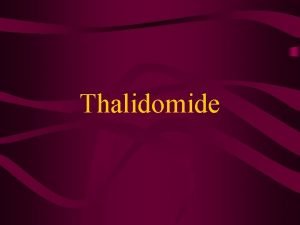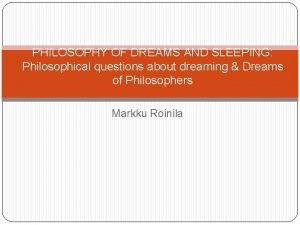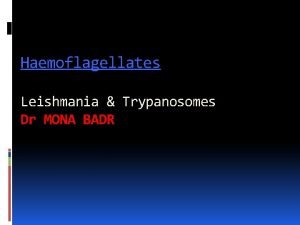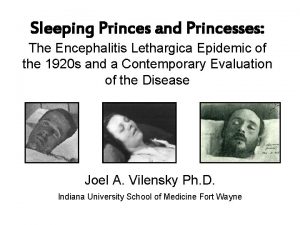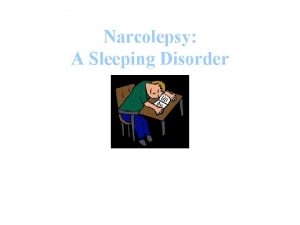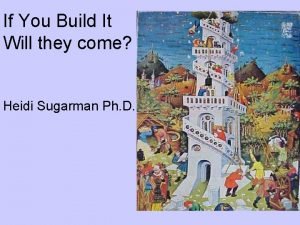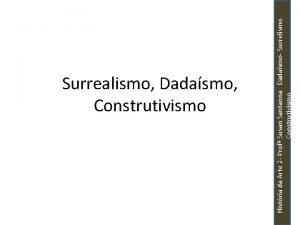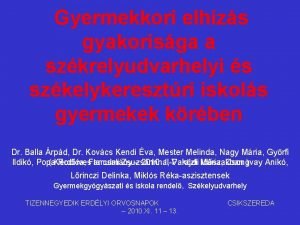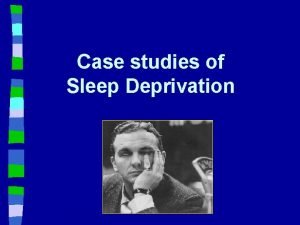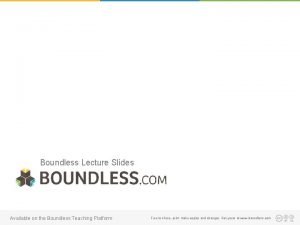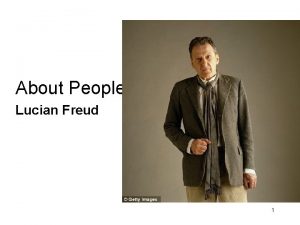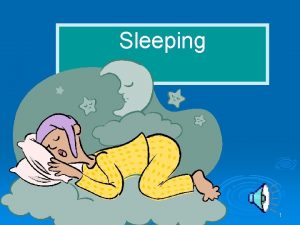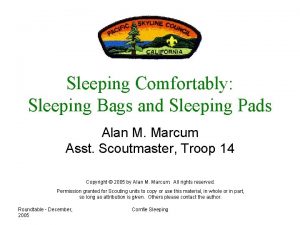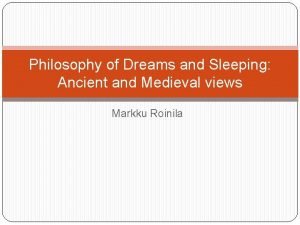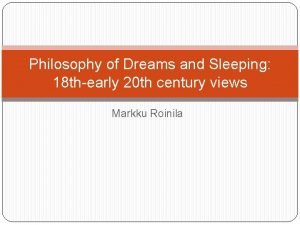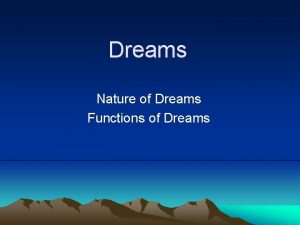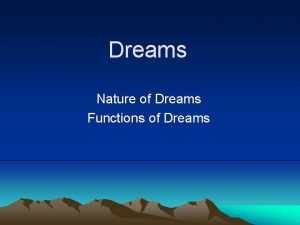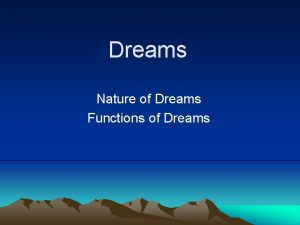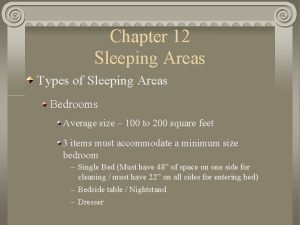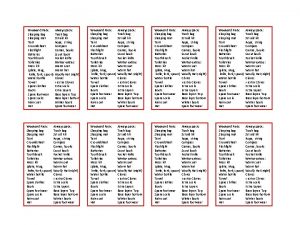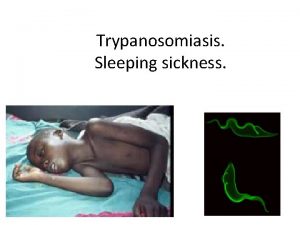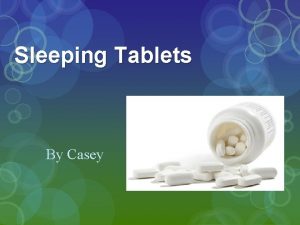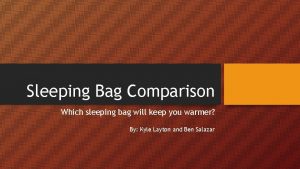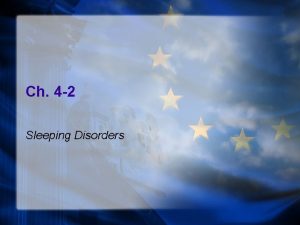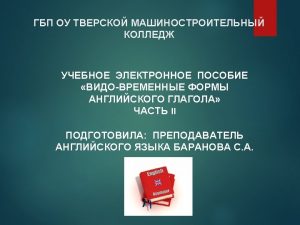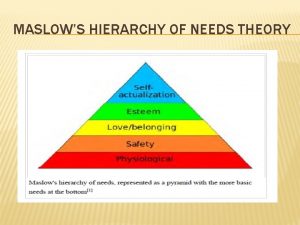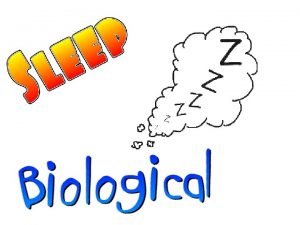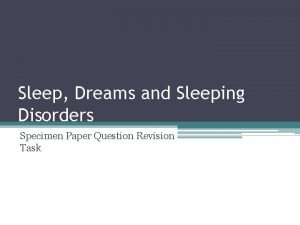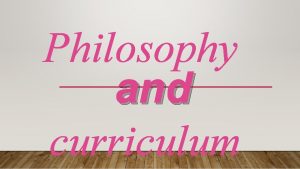PHILOSOPHY OF DREAMS AND SLEEPING Physiological theory of


![Definition of dreaming �Hobson et. al. : Dreaming is… [m]ental activity occurring in sleep Definition of dreaming �Hobson et. al. : Dreaming is… [m]ental activity occurring in sleep](https://slidetodoc.com/presentation_image/4ad24af79b5f071424d5b732d26548a6/image-3.jpg)










































- Slides: 45

PHILOSOPHY OF DREAMS AND SLEEPING: Physiological theory of dreams Markku Roinila

J. Allan Hobson and his group � J. Allan Hobson has been the foremost � � researcher on dreams in modern neuropsychological science. Has a large group of researchers with a sleep lab. Argues for brain-activation model of dreaming which surpasses all interpretative claims of dreams. It is a strongly eliminative theory. Works: The Dreaming Brain, New York: Basic Books, 1988. Dreaming: An Introduction to the Science of Sleep, Oxford: Oxford University Press 2002. A concise and polemical introduction to his views is Dreaming. A very short introduction. Oxford 2002.
![Definition of dreaming Hobson et al Dreaming is mental activity occurring in sleep Definition of dreaming �Hobson et. al. : Dreaming is… [m]ental activity occurring in sleep](https://slidetodoc.com/presentation_image/4ad24af79b5f071424d5b732d26548a6/image-3.jpg)
Definition of dreaming �Hobson et. al. : Dreaming is… [m]ental activity occurring in sleep characterized by vivid sensorimotor imagery that is experienced as waking reality despite such distinctive cognitive features as impossibility or improbability of time, place, person and actions; emotions, especially fear, elation, and anger predominate over sadness, shame and guilt and sometimes reach sufficient strength to cause awakening; memory for even very vivid dreams is evanescent and tends to fade quickly upon awakening unless special steps are taken to retain it.

Pre-history of modern brain activation model of dream psychology � Freud is the most important psychological theorist of dreams in the early stages of the discipline � Most important works: Project for a Scientific Psychology (1895); The Interpretation of Dreams (1900) � Modern scholars often think that Freud was looking for a scientific experimental method for the research of dreams, but he was 100 years too early. For this reason he was forced to resort to speculative philosophy.

Differences between Freud and modern psychology of dreams Dream phenomena Psychoanalysis Activation–synthesis Instigation Repressed unconscious wish Brain activation in sleep Visual imagery Regression to sensory level Activation of higher visual centres Delusional belief Primary process thinking Loss of working memory resulting from DLPFC inactivation Bizarreness Disguise of wishes Hyperassociative synthesis Emotion Secondary defensive response of ego Primary activation of limbic system Forgetting Repression Organic (Physical) amnesia Interpretation Needed Not Needed

Problems of interpretation of dreams � Thus the main difference to contemporary brain research method-employing psychology is that whereas in Freud’s model interpretation is always needed, in modern psychology the test results are what counts. � Hobson is right that interpretation of dreams is difficult to validate scientifically. � Interpretations are necessarily subjective and can be used to wrong purposes. For example, if dreams are thought to represent the sickness of the body the can be read as an encoded message about the future from Gods (pagan or christian). In this ways medicine men can mislead people, gain power etc.

Freud’s position � This was no problem for Freud who thought himself as a professional who could interpret dreams and show they represented the psychological problems of a patient. The professional could tell the patient things they could not know themselves as unconscious in dreams is in a constant war with the consciousness. � Hobson argues that this kind of system is really a religion (despite the fact that Freud was an atheist himself). It is based on faith in an agency that gives hidden directives, which can be understood only through the intervention of someone who could interpret the ”message”. � Hobson is right, but the same could be said about anyone trying to interpret the dreams as long as scientific methods cannot do the task.

Further criticism by Hobson � According to Hobson, Freud’s work suffered from two fatal scientific defects. � First, an absence of relevant brain science and Freud was aware of that � Second, Freud’s data was insufficient and focus narrowly fixed. Freud made no attempt to collect dream reports himself (other than his own dreams and there are not many, around 40). He could have collected more. � Furthermore, Freud ignored two important predecessors. David Hartley thought that dreaming served to loosen associations that otherwise inclined to become obsessively fixed, that is, woud lead to madness. Herman Hemholtz took a formal approach to dreams.

Dreams and sexuality � Freud attributed dreams to sexual content. They represent a displaced sexual desire. These are unconscious wishes, which come up when the ego is weakened by sleep. � For example, flying in dreams (remember Fellini’s 8½ and Hitchock’s Vertigo) represent this kind of sexual wish.

Some admissions � Robert Stickgold (who has studied especially remembering dreams and is part of Hobson’s dream-team): Freud was 50% right and 100% wrong. � Hobson: Freud understood rightly that dreams have a primitive emotional character which are loosely connected to mental content. In dreams we can find elation, joy, happiness, love, fear, anxiety, panic as well as primitive actions such as fighting, assaulting, shooting, sex, escape. � Dreaming reminds us that we have powerful instincts, emotions and even inclinations to madness that must be held in

No sex, please, we’re neuroscientists � But the modern view is that Freud was wrong: dreams are not wish fullfilment and there is a lot less sex and positive emotions than he thought. � It is also objected by Hobson that Freud saw the unconscious as compelling, but sneaky and devious element which was trying to overcome the conscious elements in the mind and which therefore has to be suppressed. � However, if it is supposed that dreams reveal rather than conceal emotion and instinct, cencorship of the unconscious is misleading and erroneous. Thus dreams are not symbols of something else like sexual wishes. Dreams are what they are. � In this respect it is interesting that the dreams of men and women are found in sleep lab tests to be strikingly similar to each other. One would perhaps think that men’s dreams would be more aggressive and women’s dreams more emotional and tender, but this is not the case. In fact, emotions are equally important in the dreams of men and women.

Hobson’s critique in a nutshell �We do not dream because our unconscious wishes or drives would, if undisguised, wake us up. We dream because our brains are activated during sleep, and we do so even if our primitive drives are turned on by that activation. It is the specific neurophysiological details of that activation process, not psychological defense mechanisms, that determine the distinctive nature of dream consciousness. We need to accept our dreams, our fears, and our rages for what they are: expressions of brains activation in sleep and in waking that have their own deep and compelling reasons for being.

Implications �This has naturally larger implications than just the philosophy of dreams. Hobbes and his colleagues strive to argue that the development of brain research will significantly alter not only psychology, but also philosophy of mind. One wonders: what is left for the philosophy of mind discuss if it is accepted that all phenomena of the mind can be reduced to brain activation or inactivation? �This is in fact one of the leading ideas of this course – how to have a philosophy of dreams if dreaming is just reduced to brain activation.

Modern scientific psychology on dreams � For modern scientific psychology, research of dreams is all about the � � activities of the brains. Therefore it is more interested in the form than the content of dreams. The approach is formal and analytic rather than interpretetive. In a way, however, it approaches the classic philosophical question of what distinction can be found between the dreaming and the waking state of man as we will see. When something is especially vivid, certain parts of the brains are activated and when something is confused (for example, if a person has features from two different persons), there is a certain amount of inactivity of some parts of the brains. Thus in dreaming (compared to waking) some mental functions are enchanged while others are diminished. Within this paradigm, dreams are defined as mental activity occurring in sleep. This is indeed hard to object: it is clear that when we are sleeping, what happens is mental, not bodily, although it might be that bodily movements affect the dreams. The mental activities vary a a lot. For example, we may have the feeling that we are moving (for example, driving a jetplane) although we are immobile in bed when sleeping. We may have anxiety dreams (for example, related to work or upcoming social event). Or the dream may be hallucinatory, having no apparent relation to reality.

Development of modern method � Although the development of modern scientific psychology would have advanced with only direct observation, the invention of EEG (recording of brain waves-technology) revolutionized the sleep research. It was invented by the German Adolf Berger. � With EEG-graphs one can study the activation and inactivation of brain neutrons. To put it plainly, in modern dream science waking and dreaming are two states of consciousness, with

Sleep basics: NREM and REM-sleep � Through the EEG-graphs it was found that there are two kinds of sleeping: NREM and REM-sleep. � An anxiety dream has to do with emotions and is a typical example of a NREM-dream which is a low-level brain activation dream and takes place often when there is only a short time between falling sleep and waking up. The term NREM means that there is no rapid eye movement during sleep (non-REM sleep). � A hallucinatory dream is a typical example of a REM-sleep which involves rapid eye movement. It is dramatic and complex, bizarre and hallucinatory and may contain delusions. It is also a long dream, about eight to ten times as long as the two other dreams. The REMsleep fully includes the elements we attribute to dreams: rich and varied perceptions and hallucinations, delusional acceptance of the wild events as real despite their improbability and physical impossibility, bizarreness following from discontinuity, emotional

Sleeping and waking � In previous times it was thought the brain is just switched off during sleep. Sometimes, but not very often we do indeed sleep without seeing any dreams. � In times of stress the mental activity continues all the night. It is also that we can see dreams almost the whole time when we are sleep, not only just because we wake up as has often been thought. � It is true that nightmares or other unpleasant dreams can wake us up. � Modern brain research has also shown that although external stimuli such as a sound, smell or suchlike can affect our dreams, but not necessarily and the dreams are certainly not dependent on those influences.

Sleeping animals � The brain activation is similar in all mammals, so in sleep laboratories one can study with animals, such as cats on sleeping and dreams. It is a more difficult question whether animals have dreams or not. � This is related to the question, popular since specially 17 th century, of whether animals have a consciousness or not. I will return to the philosophical views later, here it suffices to say that most contemporary scientists think that animals have some kind of limited consciousness which is very different from men as they lack language and the capacity for propositional or symbolic thought. On everyday experience, it would seem that animals do have dream as their behavior sometimes looks like reflecting dreams in the same way as humans do. But so far, science does not provide answer to this question. � However, what is known is that Rem-sleep always involves intense brain-activation and occurs in all mammals.

Sleeping babies � It is good to observe babies because REM-sleep starts in them immediately as they start sleeping and the brain activation is more intense and less inhibited than in adults. � We don’t know if babies dream. It seems possible, though. If babies do dream, their subjective experience cannot possibly be of the same quality as that of adults. � According to empirical tests, the accounts of dreaming that are similar to those of adults start to appear at about age three, when the infant is acquiring language and propositional thought. This would suggest that children start to dream when they start forming propositions which again would hint that there is a connection between reason and dreams. Thus brain activation would perhaps not be quite enough to produce full-scale dreams. � However, the dreams might be important to the development of the child – the frequency of REM-dreams in babies would seem to point at that direction.

Sleeping proportions � The proportion of sleeping changes in our lifetime, as does the proportion of REM and NREM-sleep. The REM-sleep takes place most of the time in fetuses and new-born babies. The idea may be that the brain is developed exactly in these stages of the development. After 26 weeks, waking increases progressively until the death. � How much sleep is needed, then? This varies very much from person to person. Some need 4 -6 hours sleep per day (for example, Thomas Edison, the inventor) and some 8 -10 (many writers, for example Proust & Graham Greene who have written on dreams), the average is 6 -8 hours. � Sleep deprivation show in that one has difficulties in being attentive and being efficient. In addition, one tends to have intense, bizarre dreams more often than when one has slept well. � Sleep deprivation may cause mental problems and therefore it is difficult to measure – the scientists would not want to experiment with mental sanity, at least if they are themselves sane. However, many have found that in extraordinary circumstances men can survive for a surprisingly long period without sleep or with reduced amount of sleep although in the long run sleep deprivation will without doubt produce various problems even to a very healthy and mentally strong person.

Functions of sleep � Sleep is essential to life itself. About two weeks of severe sleep-deprivation will produce serious problems to our functioning normally. � Our skin starts to break down and we feel cold. We lose weight however much we eat. Eventually, within a month, we start dying because of infections. � Sleep is essential in refreshing our body, in maintaining its resistance towards bacteria and to maintaining our body temparature.

Functions of sleep � Philosopher Owen Flanagan has argued in his Dreaming Souls that dreams do not have any real function in human life. We know already by experience that we have a vivid emotional life and it seems to be the fact that dreams do not have much effect to our waking life. � Many psychologists (and some philosophers such as Locke) argue that sleeping and dreams help us to organize our cognitive material and to refresh our cognitive abilities. In this sense dreaming help us to update and clean our hard disk, so to speak, clean unnecessary memories, integrate new experiences to old ones, update memories and so on. In addition, brain activation during sleep may have a developmental role which goes on all through the life. � According to Hobson, also the most important survival instincts (which involve emotions and memory) are also connected to sleeping. We need to know how to approach the opposite sex, when to mate, when to be afraid, when to run for cover. These are the skills that sleep refreshes

Nightmares � Nightmares and generally frightening or negative dreams (such as running away from some monster) contain strong and intense negative emotions. If we spontaneously wake up from a dream, it usually contains predominantly anxiety, fear or anger. Therefore the nightmares are simply caused by the intense negative emotions in dreams. � The physiological answer to nightmares is that there is an area in the brain called limbic brain which is activated when this happens. So there is an area in the brain which, when activated, produces nightmares in the same way as activation of some other areas in brain produce pleasure and positive dreams. ´

Night terror � Difference between nightmares and night terror. � Night terror is a pure emotional experience which takes place when we awaken from sleep. They are usually associated with NREM-sleep and can be related to post-traumatic stress. � Night terror affects the body very strongly: the heart starts pounding, breathing rate increases and the blood pressure arises. We wake up sweating and in terror without remembering any dreams. These kind of night terrors are typical in exsoldiers, for example. � The nigtmares, in contrast to night terrors, are perfectly normal. They are normal phases of REM-sleep, suggesting that the maintenance of these emotional systems of the brain

Other disturbances of sleep � In addition to nightmares and night terrors, there are other disturbances such as sleep walking, sleep talking and tooth grinding. � They are called as parasomnias, movement behavior that occur during sleeping. Also these phenomena are functions of the activation of brains, this time because of activation in subcortical brain tissue which is related to motor systems of a human. � These parasomnias take place during NREM-sleep – they are normal human functions except that instead of taking place while we are awake, they happen when we are sleeping. � They are not dreaming in a proper sense – their cause is partial brain activation which is enough to support movement, but not enough to support waking. In this sense sleepwalking and sleep-talking have features of both sleeping and waking.

Sleep and movement � Motion takes place also when the areas of the brain are not activated. For example, in REM-sleep there is not a lot of motion (except the eyes under the eyelids). But then the activation of motor area of the brains are actively blocked exactly to prevent motion. This makes sense as it is impossible to fall to sleep if we are not immobile. Try falling to sleep while walking! � Movement is controlled by several levels of the brains. The upper level of the brain which gives us voluntary control over movement during waking, is pretty much out of the loop during sleep. The lower structures, of which many are necessary for movement, may however be activated while the upper brain is inactive. This leads to a kind of automatic movement which is what happens, say, when the need to go to bathroom makes one sleepwalking and trying to urinate in a garden or in some other place which is not the toilet where we in the waking state do this kind of action. � A fairly newly found sleep disorder is REM sleep behavior disorder. In this strange syndrome the person enacts his or her dreams through movement. For example, one may dream of being swimming and five away from the bed or throw ball throw moving one’s hands. This happens in the REM-phase of the

Dreams and indigestion � In the past it was thought that dreams are the result of bodily affections such as indigestion. According to modern brain science, this is simply wrong. Of course, if one has a stomach ache, or has eaten or drunk too much, the processing of the food and resulting chemical disturbances are likely to lead to awakenings, and these awakenings may be associated with dream recall. When one is lying asleep in such states of gastrointestinal brain activation, it is not unlikely that mental content will be related to the dietary indiscretion. � In fact the day’s external events have very little place in the genesis of dreams. Freud thought that dreams were triggered by recent memories, but the modern psychologists find that recent memory enters into dreaming very little. Fragments of episodic memory of biographical events are incorporated, but whole recollections are never reproduced as such. Instead, only partial fragments of recent memories enter into dream construction and, along with other materials from remote memory, become part of scenarios created entirely from scratch as brain activation proceeds.

Sleep and mental illness � Hobson argues that dreaming is a � � � psychotic state as much the psychotic states we experience while being wake. The internally generated perceptions have the hallucinatory power needed to make us hopelessly delusional. Dream halluzinations make it impossible for us to realize that we are in the grasp of an altered state of consciousness. We are sure that we are awake and believe our senses and the associated emotions despite the bizarreness, incongruities and discontinuities which would immediately disturb us if we were awake. “Pinch me, I’m dreaming!” Formally speaking, severe mental illnesses and dreaming are identical. In both the question is of brain activation, physical changes in brain states. But there is an easy cure: just wake

Sleep and mental illness � Psychosis is a mental state characterized by hallucinations and/or delusions. Delusions are possible without hallucinations. Dreams, again are most like organic mental illnesses, for example deliriums which follow from drugs or high fever. We may not know what day it is or where we are. We may have huge gaps in memory. Thus in a sense we are delirious when we are dreaming. This would, again, lead to the conclusion that dreams are only confused noise, not having any significant meaning or cognitive information. � Hobson: ”Going to sleep entails the enabling of a distinctive brain activation process akin to delirium: delirium is state that we thought we could get only be being bad or by taking drugs such as alcohol, amphetamine, or atropine, or by outliving our brains – in the senile conditions of old age. Suddenly we find out that it happens to all of us, every night of our lives, and probably more when are being good than when we are being bad, and more when we are younger than when we are old!” � Delusions are sort of chemical imbalance

Dreams, memory and learning �The common misconception that our dreams are black and white is due to poor memory. �We dream in color. In the thousands of lab dream reports, there is not a single instance of wellrecalled dream being in black and white, as would be expected if this were indeed normally the case.

Dreams and Learning � There is a theory according which the function of dreaming is to re-organize memory during the sleep. The most well-known theorist in contemporary psychology is Robert Stickgold. � The idea in this theory is that dreams are composed of memory fragments which seems to be supported by recent experiments with REM-sleep although even more recent experiments show that NREM-sleep is equally important to men. � The research in this area is developing: the learning and memory processes that sleep may affect have been better characterized and differentiated. Also, thanks to progress in basic sleep neuroscience, the brain dynamics that appear to support the differentiated aspects of learning and memory are now known in enough detail to allow modelling of the sleep learning process. � So although there is an interpretation that dreams do not really have any significant function in human life other than maintaining our self-survival behavior, there also views according to which dreaming can help us in learning and memory. However, this learning and memory reorganization does not necessarily have to be conscious – it may happen without us ever being aware of it.

Memory re-organization in sleep �So far, the modern science does not know the rules of the memory re-organization. We can only hope that advances in technology and brain science can some day reveal the rules to us. �Experiments with animals (especially with rats who are quick learners) show that REM sleep increased when rats were exposed to new learning. Preventing REM-sleep, again, impaired learning. However, however quick learning can be, it can take several days and possibly a week until new information is used to change one’s methods of doing things. Learning is simply not a very quick process and it is typically unconscious.

Recurrent dreams � We may have recurrent dreams concerning exams or teaching or any other activity which includes performance to other people. � They usually contain strong emotions or anxiety which is related to the feeling that one is not prepared properly to do what one is supposed to do. Thus it is no wonder that we have anxiety about performing – if we can’t remember what to do or say, we fail in the performance. � Another kind of recurrent dream may be related to learning. For example, when one is learning something new, say, a game (tetris, for example), one may see in dreams fragments of the learning activity.

Lucid dreaming � Sometimes dream events are so incredible as to make us wonder if we are awake or not. This disbelief can be increased and converted into the recognition that we are, in fact, dreaming. � When we are awake, we can check on our knowledge very easily. We are able to make voluntary movements; we are able to control our thoughts; we can pinch ourselves and see that we feel things and are behaving in relation to external stimuli. � In dreaming, we normally lose this self- reflective awareness; we are unaware of the state that we are in; we are unable to control our thoughts; and we are unable to make critical judgments. � During dreaming, some individuals become spontaneously aware that they are dreaming. This occurs naturally in children who are aged eight and above, and continues through

Inducing lucid dreams � Lucidity can be induced by techniques that anyone can follow. � I put a notebook by my bedside along with a pen to record dream experience and then, before going to sleep, I tell myself that, being a normal human being, it is likely that I will have two hours of absolutely fabulous dreaming tonight. To tune in on some of it I am going to notice when bizarreness occurs. � I tell myself to notice things that could never occur in waking but typically occur in dreams, namely the changes of times, places, and people (especially the unusual occurrence of unidentified characters, characters with the qualities of one person who suddenly have those of another, and so on). This fluidity of the orientation functions – time, place, and person – is what is going to tell me that I am dreaming. � When I am successful, a part of my brain–mind wakes up and I am able to notice that I am dreaming and say so to myself. Having done so, I have created a kind of dissociation: part of my brain is in the waking state and part is in the dreaming state. And then I can have a lot of fun. I can watch the dreams, I can induce awakenings so as to increase my recall, and, best of all, I can influence the dream content. I can do whatever I please; well, almost whatever. I can certainly fly and can have whatever sorts of intimate relationships I choose with my other dream characters. This is usually enough to make people quite proud and pleased to have achieved lucid

Criticism of Hobson � Although Hobson has refined his � � theory over time, it is still basically reductive in the sence that all the phenomena of the mind have a corresponding scheme of brain activation. Sometimes Hobson argues as the brain is the object of mind phenomena This would make the mind redundant – if all we think, reason, will etc. Is nothing but brain activation, where do we need the mind for? Arguably the dreams present us with interesting things – one might think that they are something more than just neurochemistry What else?

Other psychological theories �We have discussed the views of Allan J. Hobson and his team. �Although Hobson is by far the foremost theorist of dreams in modern psychology, there are some alternative theories which are founded on the same kind of experimental science. �I will briefly discuss alternative theories such as evolutionary psychology theory, psychosomatic theory, expectation fulfilment theory and theories of Solms and Foulkes.

Solm’s criticism � Mark Solms is a clinical neuroanatomist, so he shares Hobson’s basic approach. � However, he has shown that there are dreams also in NREM-phase of sleep (Hobson earlier thought there was only REM-dreams) and that they are not always dependent on brain activation. � The basic approach however is that brain activation is the explaining cause of most dreams. Solms is not interested in the content of dreams. � Difference with towards Freud: whereas Hobson thinks dreams are related to

Adler: Dreams are emotional preparation � A pioneer for the evolutionary psychology theory of dreams (discussed next) was perhaps Alfred Adler (1870 -1937) who suggested that dreams are often emotional preparations for solving problems, intoxicating an individual away from common sense toward private logic. The residual dream feelings may either reinforce or inhibit contemplated action.

Evolutionary psychology theories of dreams � Many (incl. Philosopher Owen Flanagan and Hobson) argue that dreams serve no specific purpose. They are just epiphenomena (In philosophy of mind, epiphenomenalism is the view that mental phenomena are epiphenomena in that they can be caused by physical phenomena, but cannot cause physical phenomena; In medicine, an epiphenomenon is a secondary symptom seemingly unrelated to the original disease or disorder. ). Hobson argues that the substance of dreams have no significant influence on waking actions and most people get on well without remembering their dreams. � This view is objected by evolutionary psychologists who believe that dreams surve some adaptive function for survival. � Deirdre Barrett describes dreaming as simply "thinking in different biochemical state" and believes people continue to work on all the same problems—personal and objective—in that state. Her research finds that anything—math, musical composition, business dilemmas—may get solved during dreaming (we will see that some Early Modern philosopher anticipated this view). � In a related theory by Mark Blechner, titled “Oneiric Darwinism, " dreams are seen as creating new ideas through the generation of random thought mutations. Some of these may be rejected by the mind as useless, while others may be seen as valuable and retained.

Antti Revonsuo: threat simulation theory � Finnish psychologist Antti Revonsuo posits that dreams have evolved for "threat simulation" exclusively. � According to Threat Simulation Theory much of human evolution physical and interpersonal threats were serious, giving reproductive advantage to those who survived them. Therefore dreaming evolved to replicate these threats and continually practice dealing with them. � In support of this theory, Revonsuo shows that contemporary dreams comprise much more threatening events than people meet in daily non-dream life, and the dreamer usually engages appropriately with them. � It is suggested by this theory that dreams serve the purpose of allowing for the rehearsal of threatening scenarios in order to better prepare an individual for reallife threats.

Psychosomatic theory of dreams � Tsai developed in 1995 a 3 -hypothesis theory that is claimed to provide a mechanism for mind-body interaction and explain many dream-related phenomena, including hypnosis, meridians in Chinese medicine, the increase in heart rate and breathing rate during REM sleep, that babies have longer REM sleep, lucid dreams, etc. � Dreams are a product of "dissociated imagination, " which is dissociated from the conscious self and draws material from sensory memory for simulation, with feedback resulting in hallucination. By simulating the sensory signals to drive the autonomous nerves, dreams can affect mind-body interaction. In the brain and spine, the autonomous "repair nerves, " which can expand the blood vessels, connect with compression and pain nerves. � Repair nerves are grouped into many chains called meridians in Chinese medicine. When some repair nerves are prodded by compression or pain to send out their repair signals, a chain reaction spreads out to set other repair nerves in the same meridian into action. While dreaming, the body also employs the meridians to repair the body and help it grow and develop by simulating very intensive movementcompression signals to expand the blood vessels when the level of growth enzymes increase.

Expectation fulfilment theory of dreams � Joe Griffin (1997): expectation fulfilment theory of dreams. � Dreaming serves to discharge the emotional arousals (however minor) that haven't been expressed during the day, thus freeing up space in the brain to deal with the emotional arousals of the next day and allowing instinctive urges to stay intact. � The expectation is fulfilled, i. e. the action is 'completed', in the dream but in a metaphorical form, so that a false memory is not created. � The theory satisfactorily explains why dreams are usually forgotten immediately afterwards: as Griffin suggests, far from being "the cesspit of the unconscious", as Freud proclaimed, dreaming is the equivalent of the flushed toilet.

David Foulkes on child dreaming � Foulkes and his team have researched � � � the dreams of children around twenty years. He rejects the common idea that children have dreams from infancy in the same form as later. This is supposed to be because children have more REMdreams than adults and formerly it was thought that we can see dreams only in REM-phase of the sleep. Foulke’s results show that younger childre (3 -5 years old) dream very little – around 15% of REM-awakenings elicited dream reports Until 9 -11 years only about 30% of REMawakenings resulted in dream reports Years 12 - frequency increases swiftly to typical adult rate of 80% The results seem not to be dependent on verbal skills - Foulkes argues that it is not likely that the younger children were having rich dreams but failed to

Consequences � Instead, along with the development of narrative memory and theory-of-mind capacities, the gradual development of a rich visual-spatial imagination may be among the key cognitive prerequisites for a fuller dream life. � Therefore Foulkes would conclude that we learn dreaming as we develop: “Dreaming is an organizing, constructive process which requires cognitive sophistication, and is continuous with waking cognitive and emotional life. ” � Foulkes argues that dreaming is at heart an organizing process, a high-level symbolic skill, and a form of intelligent behaviour with cognitive prerequisites. The virtual world we inhabit in dreams is one which we have constructed, though usually without either voluntary control or current sensory input. � This would naturally go against Hobson and Solms – one cannot “learn” brain activation – it is there at least in an early age if not in infancy. � Foulkes has been critisized on the test conditions – do children dream in the same way in the laboratory as in home? Etc. Problems with reliability of dream reports in children etc.
 Descartes dreaming argument
Descartes dreaming argument Activation-synthesis theory dreams
Activation-synthesis theory dreams Information processing theory of dreams
Information processing theory of dreams Activation-synthesis theory dreams
Activation-synthesis theory dreams Activation synthesis theory of dreams
Activation synthesis theory of dreams Psychoanalytic theory dreams
Psychoanalytic theory dreams James lang theory
James lang theory Masolow
Masolow Physiological arousal theory
Physiological arousal theory Family and friends 2 pracovný zošit odpovede
Family and friends 2 pracovný zošit odpovede Hopes dreams and aspirations
Hopes dreams and aspirations Goals vs dreams
Goals vs dreams Rascal flatts my wish for you
Rascal flatts my wish for you Winter dreams questions
Winter dreams questions Cover yourself with hopes and dreams
Cover yourself with hopes and dreams What is the dapps rule
What is the dapps rule Sleeping giant ww2
Sleeping giant ww2 Present perfect tense for sleep
Present perfect tense for sleep Mummy bear porridge bowl
Mummy bear porridge bowl Tonsil grading
Tonsil grading Trypanosomiasis
Trypanosomiasis The sleeping gypsy analysis
The sleeping gypsy analysis Sleeping freshmen never lie answers
Sleeping freshmen never lie answers The man behind the moon by shelton pacer genre
The man behind the moon by shelton pacer genre Sleeping barber problem using semaphores in c
Sleeping barber problem using semaphores in c Brother john morning bells are ringing
Brother john morning bells are ringing Thalidomide sleeping pill
Thalidomide sleeping pill What is the angels name
What is the angels name What was descartes excuse for sleeping late
What was descartes excuse for sleeping late African trypanosomiasis life cycle
African trypanosomiasis life cycle Sibilant sounds
Sibilant sounds Encephalitis lethargic
Encephalitis lethargic Sleeping barber problem solution using semaphore in c
Sleeping barber problem solution using semaphore in c Salvador felipe jacinto dalí domènech
Salvador felipe jacinto dalí domènech End rhyme
End rhyme Deuce bigalow sleeping disorder
Deuce bigalow sleeping disorder Sleep position
Sleep position Invisible sleeping woman horse lion
Invisible sleeping woman horse lion If thou hast nature in thee bear it not
If thou hast nature in thee bear it not Kendi réka
Kendi réka Cute pigs
Cute pigs Peter tripp sleep
Peter tripp sleep Image of a child sleeping
Image of a child sleeping اکسپرسیونیسم naked man with rat
اکسپرسیونیسم naked man with rat The world is too much with us imagery
The world is too much with us imagery Sleeping pad target
Sleeping pad target
